This essay analyses advertisements for consumer culture, ‘the commodity culture’. By looking at semiotics and Saussure’s concept of the sign and also explaining what is meant by the signified and the signifier, we will look at the linguistic model and explain how this applies to the chosen advert or adverts that are analysed. The essay will investigate commodity culture and show the commodity fetishisms of consumers and discuss the theories of Marxism and how they also relate to the adverts. Evidence of Romanticism and naturalistic elements will be investigated using Williamsons view on ‘the natural’ and the ‘unnatural’. Finally the essay will discuss the psychoanalytical ideas of Freud and Lacan in terms of dreams, desire, fantasy and the concept of the ‘mirror phase’ from Williamson.
Inhaltsverzeichnis (Table of Contents)
- Introduction
- Semiotics and the Sign
- Langue and Parole
- Signifier and Signified
- Commodity Culture and Fetishism
- Marxist Theory
- Commodity Fetishism
- Romanticism and Naturalism
- The Natural and the Unnatural
- Romanticism and Perfectibility
- Psychoanalysis and Fantasy
- Dreams and Desire
- Fantasy and the Mirror Phase
- Conclusion
Zielsetzung und Themenschwerpunkte (Objectives and Key Themes)
This essay examines advertisements for consumer products, specifically focusing on how they promote and sell a "commodity self." It analyzes the semiotics of these advertisements, exploring the relationship between signifiers and signifieds to understand how they create meaning. * **Semiotics and the Construction of Meaning:** The essay examines how advertisers utilize language and imagery to create signs that sell products and cultural meanings. * **Commodity Culture and Fetishism:** The essay explores how advertising creates a "commodity self" by promoting a sense of desire and envy for products that promise social status, beauty, and fulfillment. * **Romanticism and Naturalism in Advertising:** The essay analyzes how advertisements often use natural elements and idealized representations of beauty to appeal to consumers' desires for perfection and authenticity. * **Psychoanalysis and the Role of Fantasy:** The essay investigates how advertising utilizes concepts from psychoanalysis, such as dreams and fantasy, to create a sense of desire and connect with consumers on an emotional level. * **The Mirror Phase and Identity Construction:** The essay discusses how advertisements utilize the "mirror phase" to create a sense of identification with the products and the lifestyles they represent.Zusammenfassung der Kapitel (Chapter Summaries)
- Introduction: This section introduces the topic of the essay, focusing on the analysis of advertisements for consumer culture and the concept of the "commodity self."
- Semiotics and the Sign: This section delves into the theories of Ferdinand de Saussure and his concepts of langue, parole, signifier, and signified. It explores how advertisers use language and imagery to create signs that sell products and cultural meanings.
- Commodity Culture and Fetishism: This section examines Marxist theory and how it relates to the consumption of commodities in capitalist society. It also discusses the concept of "commodity fetishism," where products are given exaggerated meaning and status beyond their actual use value.
- Romanticism and Naturalism: This section explores the use of natural elements and idealized representations of beauty in advertising. It analyzes how these elements appeal to consumers' desires for perfection and authenticity, drawing on the ideas of Romanticism and its focus on nature and the ideal.
- Psychoanalysis and Fantasy: This section investigates the use of psychoanalytic concepts, such as dreams and fantasy, in advertising. It examines how these concepts create a sense of desire and connect with consumers on an emotional level, linking it to the concept of the "mirror phase" in which consumers identify with the products and the lifestyles they represent.
Schlüsselwörter (Keywords)
The key concepts and topics explored in this essay include semiotics, commodity culture, fetishism, Romanticism, naturalism, psychoanalysis, fantasy, the "mirror phase," and the "commodity self." These terms reflect the essay's focus on the ways that advertising constructs meaning, promotes consumption, and shapes identity in contemporary society.- Citar trabajo
- Lea Weller (Autor), 2009, An Analytical Study into Advertisements for the ‘Commodity Self’, Múnich, GRIN Verlag, https://www.grin.com/document/264576



